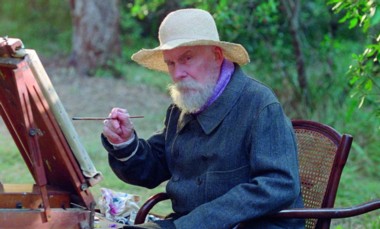Few names span the history of modern art like that of Renoir. Beginning with 19th-century painter Pierre-Auguste, the Renoir bloodline has come to touch a dizzying array of artistic fields. While the man who gave us “Luncheon of the Boating Party” would have been a legend on his own, he also fathered an actor (Pierre), a filmmaker and author (Jean), and a ceramic artist (Claude). He was also grandfather to Pierre’s son—another Claude, whom we’ll revisit in a bit—who went on to work in Hollywood.
It’s the relationship between the elder Renoir and middle son Jean that makes up the drama of Gilles Bourdot’s new film Renoir. Set on the Côte d’Azur in 1915, it begins with Pierre-Auguste, already desolate over the loss of his wife, confronted with the news that his son Jean, off fighting in the Great War, has been injured in battle. But as Jean heads home to convalesce, the fading Auguste meets a young woman (Christa Theret as Andrée) who sparks a bit of the old art in the man.
With Andrée as his muse and model, the painter returns to his beautiful nudes. But Jean, too, falls under Andrée’s spell—in a time of scarcity and war-bred depression, her exuberant embrace of a richly lived life affects both men like absinthe on an empty stomach. Suddenly, father and son—while they both pursue Andrée for different reasons—are competitors of a sort.
But she is no mere plaything—Andrée stands at a remarkable crossroads in the history of art. The last muse of a dying genius, she would also become the young wife of his son, and then the star of that man’s early films (under the name Catherine Hessling). Renoir fils would go on to make some of cinema’s most celebrated films, including the classic Grand Illusion. And while it may be the family name that has stood the test of time, it may well have been Andrée—who first pushed her husband to pursue filmmaking—who has had the most lasting effect on our modern art.
For its part, Bourdot’s film is luxuriously photographed by Mark Ping Bing Lee, whose work will be familiar to moviegoers from the lush visuals of Wong Kar Wai’s sumptuous In The Mood for Love. Recalling the soft light of its subject’s paintings, the gorgeous depth of its glow is enough to make one overlook the small, melodramatic, missteps. “Renoir’s paintings make me so hungry,” says young Jean. Says his future wife, “Do you they make you hungry for me?” Ooh la la.
Also this week: In an odd bit of serendipitous scheduling, Joseph L. Mankiewicz’ 1963 epic Cleopatra comes to Hadley for a screening at Cinemark. While it features a cavalcade of stars—most notably the power couple of Elizabeth Taylor and Richard Burton—for the purposes of this column, it’s a smaller name that gets the attention. As it happens, one of the crew on that film was Claude Renoir, the grandson. If you decide to take in a bit of the Egyptian spectacle (the highest grossing film of 1963, it still ran a loss due to its enormous production costs), take a moment to appreciate the Renoir touch—fittingly, Claude worked on the lighting.
And if you want a more modern spectacle, start warming up your iPad/Wii/AppleTV—or whatever you use to stream your Netflix queue. The new season of the critically acclaimed (but still canceled) Arrested Development—the first in seven years—will be out on May 26, but only via Netflix. It’s proving to be an interesting time for the DVD-and-streaming giant; with a clutch of original series making waves (one starring Oscar winner Kevin Spacey), the Arrested Development experiment gives them a chance to show what they can do with a true cultural touchstone. With a little luck, we may find that, when the season is over, the entertainment landscape will be changed for good. For now, we can only wait, see, and laugh.•
Jack Brown can be reached at cinemadope@gmail.com.



